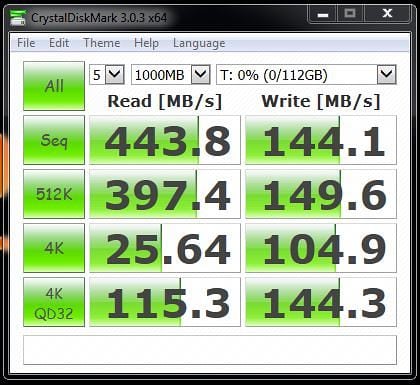Test System Setup
As we mentioned, this would be the perfect generational step up for anyone running an older SSD, or is stuck with, SATA2 ports (or those crappy Marvell SATA3 ports that made their way onto some X58 boards). It doesn’t rely on a newer slot or port, but instead, employs the bandwidth already built into your PCI Express slots. It’s the perfect place for high throughput devices like the Plextor M6e, so we decided to throw it into our video editing workstation, that’s still running the very powerful Intel X58 chipset, along with a Core i7 980X processor. Our GIGABYTE G1.Killer Assassin X58 board does indeed, have those crappy, Marvell SATA3 ports, but it also has a lot of hungry PCI Express slots that aren’t full of stuff.
Besides the board and the CPU, our operating system of choice will be Window 7 Ultimate 64-bit, all patched. We’ve got 48GBs of ADATA DDR3 1600MHz memory onboard, and for GPU duties, we’ve been rendering our projects with the still very powerful, NVIDIA GTX 690. The Plextor M6e will be compared against two other storage solutions that we currently make use of in this system, which includes and ADAPTEC RAID 3805 controller with four 1TB Seagate SAS Drives onboard, running in RAID 0, and a Kingston HyperX 3K 120GB SSD, running off one of the Marvell SATA3 ports onboard.
Installation Notes
The Plextor M6e boasts a high level of compatibility, even with our older X58 platform. Despite being a “gamer” board, the M6e installed uneventfully into one of four PCI Express slots (we chose the one closest to the GPU) and booted up, loading its own BIOS. Then it zipped right into Windows 7, where we quickly used disk manager, to quickly format and setup the drive, and we experienced nothing out of the ordinary. It was exactly the same as installing any other SATA device. In fact, drivers aren’t even needed.
Benchmarking Results – CrystalDiskMark
Our first round of benchmarks includes the latest version of CrystalDiskMark, which gave us some very impressive numbers for the Plextor M6e (above), even slightly faster than the ones we achieved in our test of the Plextor M6e M.2 2280 bare drive. This is extremely good news for anyone that wants today’s technology, on yesterday’s still very capable systems. What’s even more impressive is how it fares against the two other storage options mentioned…
The Kingston HyperX 3K 120GB SATA SSD (above), hobbled slightly by the older Marvell controller, on our X58 platform, definitely gives it up to the Plextor M6e in the PCIe slot. With the slight exception of 4K write speeds, the PCI express powered M6e runs over it. Even if the HyperX 3K SSD was attached to a more healthy SATA3 controller in one of today’s platforms, the results would still be significantly in favour of the Plextor M6e.
The Plextor M6e also does fantastically well against our ADAPTEC 5805 powered RAID 0 array (above), which is using four 1TB Seagate SAS drives. Considering that the amount of storage we need for this array is nowhere near 4TBs, we could easily get away with a single Plextor M6e in the 512GB version for our video editing duties under Adobe Premiere Pro CC. It would end up removing a lot of additional bulk and complexity. A much smaller, high performance, video editing system, can easily be realized with the use of these types of high speed storage products.
Let’s run through one very important benchmark that will tell us if the M6e would really make a worthwhile upgrade for our system.






